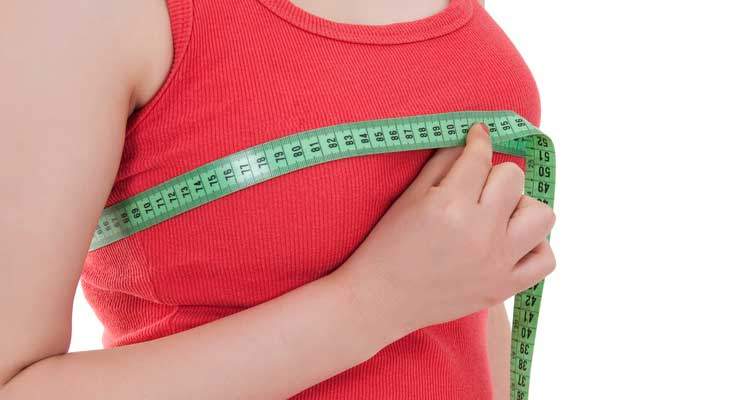Breasts are significant features of the female anatomy. Girls may start to develop breasts as early as 8 years old, but breast development may not start until the early teens. Most women’s breasts are fully developed by the time they reach their early 20s, and breast size will remain fairly stable, though it may fluctuate due to overall weight gain or pregnancy. Average breast size of a woman is unique and is generally dictated by genetics.
Average Breast Size of a Woman
Function
The primary physiological purpose for breasts is to nourish infants. Female breasts are made up primarily of fatty tissue that surrounds of milk glands, called lobules, and milk ducts. The lobules contain tiny milk sacs called alveoli. Milk passes from the alveoli through the milk ducts to the nipples, where it is secreted as the infant breastfeeds. The breasts are connected to the chest wall by connective tissue.
Significance
Opinions about the optimum size for the female breast are just that — opinions. The size of the breast has no bearing on a woman’s ability to breastfeed, nor does size affect breast sensitivity or sexual arousal in women. Breast size may play a role in sexual attraction, although the preferred breast size may change with time and culture. Twenty-first-century trends in the United States tend to favor large breasts, while Renaissance-era Italy idealized women with small breasts and large hips.
Size
Breast size is typically quoted in bra size, which includes measurements of the band and the cup. The band size is determined by measuring around the chest directly beneath the breasts and rounding the figure to the nearest inch. If the figure is even, add 4 inches. If the figure is odd, add 5 inches. The cup size is determined by measuring around the fullest part of the bust and rounding the figure to the nearest inch. Bra size, and consequently breast size, is determined by subtracting the band measurement from the cup measurement. Each inch represents one cup size which is expressed in letters beginning with A: i.e., a 1-inch difference represents an A cup, while 3 inches difference represents a C cup. Differences of greater than 4 inches are typically expressed in factors of D, such as DD or DDD.
Averages
There is considerable debate on the average breast size of a woman. Forty-four percent of American women are B cup size, and an additional 28 percent are C cup size, according to BreastOptions.com. Less than 1 percent of the female population has a breast size larger than a D cup. Time Magazine pegs the average breast size at 36C. LiveScience.com also reports an increase in the average size of breasts from 34B to 36C since 1995, although there is no explanation for the increase in size.
Considerations
Breast size is determined primarily by heredity. There are no muscles in the breasts, so no amount of exercise can make them bigger. Breast are mostly made up of fatty material, so significant weight loss may decrease the size of the breasts in proportion to overall weight loss. Overly large breasts can cause physical, emotional and psychological problems, and some women may opt for breast reduction surgery to help alleviate those problems. Women who feel their breasts are too small may opt for breast augmentation surgery, which is one of the most commonly performed cosmetic surgery procedures in the United States.
How To Measure Your Breast Size:








I know this post is 4 years old and I only stumbled across this on accident but really wanted to tell you the +4/5″ method is very out dated. It was a necessity when bras were made from non stretch materials, but now bras are made with stretch built in so adding inches makes your band too big. No other clothing item are you adding multiple inches on to get your size, so why do it with a garment that needs to fit snugly to do its job. A too loose bra is an unsupportive bra.